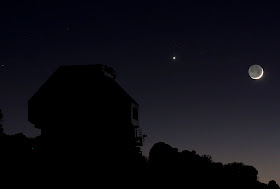Tonight I was scheduled to direct a Kitt Peak Advanced Observing Program (AOP), but the guest was a no-show. While waiting for him to arrive, I took a few opportunistic photos while hanging around the Visitor Center. The early sunset happens to fall over Tucson and I noticed last week in a visit that many roadside signs that use glass microspheres (to appear brighter under headlight illumination) appear brilliantly lit when exactly opposite the sun. The first image shows the mountain shadow creeping over Ryan Airfield on the way to Tucson. All the reflectors, as well as roadside traffic signs are redirecting sunlight back to me. It is a really cool effect, and visible to the naked eye, even from a distance of 25 miles.
It was quite a clear day and though breezy on the Mountain, transparency was very good. For a few trips I've been wanting to image the shadow of the Mountain ascend into the sky as the sun goes down. The effect is quite well known, but few people have observed it - mostly because most people are watching the sunset on the other side of the sky! The sky has to be very clear, and I've seen better, but it showed up nicely. Mostly the shadow appears pointy, but tonight, being near the VC right in the center of the mountain, the shadow appeared flat-topped or slightly rounded. I'm thinking about chasing down the upcoming partial lunar eclipse setting at the tip of the mountain shadow in a couple weeks...
With the new moon occurring a day or two ago, I saw that the thin sliver of the moon was to be very near brilliant Venus after the sunset. Of course, being up at the Observatory, it was easy to place a telescope or two in the foreground. Shown here in the wide field are the WIYN 0.9 meter, the NOP 0.4 meter and the WIYN 3.5 meter telescope structures. And the closeup shows just the WIYN 3.5 meter next to the celestial alignment. Venus' stellar flares are caused by diffraction from the lens' iris edges. Of course, the skinny moon's "dark" side is lit up by Earthshine, since viewed from the nearly-new moon, the brilliant full Earth lights it up.
Lastly, shortly before giving up the wait for the guest, I had set up an ultra-wide 8mm fisheye lens to image the Milky Way/Zodiacal Band confluence. It seems lately that the band has been brighter than I remember - it seems more easily visible across the entire sky. The Zodiacal Light (the fainter band angled towards upper left in this image) is caused by dust in the plane of the solar system, and in this image reaches from Sagittarius, where the ecliptic crosses the Milky Way, up to the planet Jupiter, just appearing in the upper left corner of the field. In another month or two, as the ecliptic makes a sharper angle with the horizon, the Zodiacal Light should get brighter - even brighter than the remnants of the Summer Milky Way that is visible here.
So even though I had hoped to be up observing all night, I was home by 9:30, but still got to see a few amazing things!





The band and gegenshein are quite visible from the summit and the 9k level. Have observed them a few times over the last few years. I will have to take a look and see if I can note any brightening next time I have a chance.
ReplyDeleteYou should send the WIYN, Venus, Moon shot to APOD.
ReplyDeleteYou should send the shot of WIYN, Venus & the Moon to APOD.
ReplyDelete